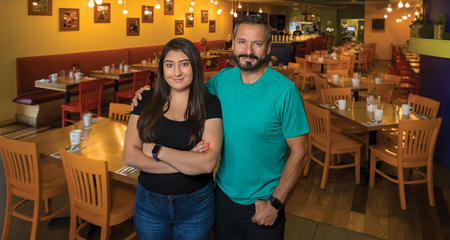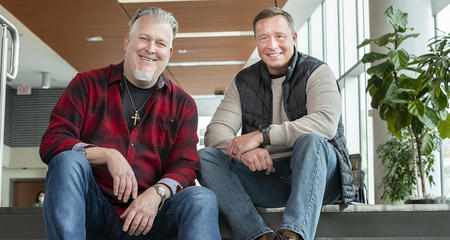
Endovascular Team Defines New Thresholds of Complex Treatment
In recent years, vascular surgery has evolved, offering minimally invasive endovascular options for patients who would have otherwise been treated with more invasive procedures, like open surgery.

Vascular surgery has evolved rapidly in recent years, providing patients minimally invasive endovascular options for situations that previously would have been treated with open surgery. The Froedtert & the Medical College of Wisconsin endovascular team combines vascular surgery and interventional radiology experts to bring these newer treatments to patients and referring physicians throughout the region.
“The endovascular field encompasses all procedures done with wires and catheters to approach vessels from inside, entering percutaneously or through a blood vessel cutdown,” said Peter Rossi, MD, vascular surgeon and MCW faculty member. “It allows us to treat these conditions under X-ray through remote locations that would otherwise require open surgery.”
Endovascular specialists address a wide variety of disorders, such as aortic aneurysms and occlusive disease that involves the carotid arteries in the neck, renal arteries that lead to the kidneys or the peripheral arteries in the legs.
“We perform the whole continuum of procedures, from the straightforward to the complex,” Dr. Rossi said. “A standard aortic aneurysm, for instance, may need two or three stents, which we place through the groin, and the patient goes home the next day. A complicated repair may require special stents that we make ourselves and increased time in the hospital, but it is still less invasive than traditional surgery.”
Abdominal Aortic Aneurysm: Location Matters
The patient’s anatomy and the area of the repair within the body — as well as their physical condition — largely determine the degree of complexity of the procedure. The majority of aortic aneurysms below the renal arteries, for example, are straightforward and can be treated with commercially available stents.
“When the repair involves the kidney arteries or the arteries that go to the liver or intestines, we have to maintain blood flow to all the arteries,” Dr. Rossi said. “We use special stents that have holes in them and are custom made to the patient’s anatomy.”
If the repair is not urgent, the Froedtert & MCW endovascular team will take a CT scan of the patient’s artery and send it to one of the companies that manufactures custom stents. In some situations, however, physicians have to engineer a solution themselves.
“Sometimes, we have to do what is called physician-modified endovascular grafting,” Dr. Rossi said. “We look at the patient’s CT scan, open a stent, cut holes in it, sew rings around the holes, place it back in a delivery device, and then put other stents in the openings we’ve created to maintain flow to those other arteries.”
The endovascular team routinely implements new technology and participates in clinical trials to bring new devices to patients. Examples include branched stent grafts to treat complex iliac artery aneurysms and new devices that allow treatment of more complicated aneurysms that encroach on the renal arteries.
For some patients with anatomy unfavorable for stenting, such as significant blockages or severe angles to the aneurysm, surgery remains the best option. Advancements in technology and experience, however, have accelerated the trend toward stenting.
“We’ve gone from about 90% open surgery to about 10-25%,” Dr. Rossi said. “Stenting has increased to about 75%. The delivery systems and devices have become much better, and we’re now using the fifth and sixth generations of these stents, which are much smaller and more flexible. The range of sizes has also increased.”
Dr. Rossi also cited the improvement that comes with specialization. “We have a dedicated group doing this every day, which makes it more routine and much safer. In addition, the vascular surgeons and interventional radiologists in the group — one of the largest practices in the country — perform procedures together, each augmenting the other’s skills.”
They apply their expertise to treating other vascular disorders beyond aneurysms. “With occlusive disease, when blockages cut off blood flow to an area of the body, other areas of the body get involved as well. These may include the carotid arteries and the arteries that go to the kidneys, intestines and legs.”
Depending on the complexity, the problem may be reviewed at the weekly multidisciplinary case conference. “When patients come to the Froedtert & MCW endovascular team, they get all of us,” Dr. Rossi said. “We can offer the whole range of options for the best, long-term success.”
A Hybrid Approach: The Best of Both Methods
The right treatment may be one of the sophisticated hybrid procedures performed by the endovascular team that involves both surgical and endovascular techniques. They are performed in a dedicated hybrid suite, which combines an operating room and an imaging lab. An example is transcarotid artery revascularization (TCAR), which temporarily reverses blood flow in the carotid artery to make stenting safer than the traditional approach of placing a stent through the femoral artery.
“The risk of stroke is up to 10 times higher when going through the groin to stent the carotid artery compared to traditional surgery, which would be a carotid endarterectomy,” Dr. Rossi said. “TCAR reverses blood flow before we ever cross the blockage, protecting the brain from any debris that might be dislodged. TCAR has a stroke rate comparable to open surgery.”
Cases of multiple blockages are also amenable to the hybrid approach, such as the common femoral artery in the groin and arteries in the pelvis. “We do surgery on the groin artery and sew a patch on it, and then go up with a wire and open the pelvic blockages,” Dr. Rossi said. “It’s a combination of open surgery and endovascular all at once and one of the most common operations we do.”
In addition, surgeons can treat multilevel blockages in the knee, leg and below the ankle, as well as blockages in the mesenteric vessels using the hybrid approach.
“The newer procedures are not for everybody, but our multidisciplinary team is well qualified to determine what’s best for patients and help them arrive at the best treatment decision,” Dr. Rossi said.
Regardless of the procedure, patients benefit from the continual advancement of endovascular treatment at the Froedtert & MCW health network.
“The biggest advantages that patients have are decreased cost, quicker recovery, less pain and a faster return to normal life,” Dr. Rossi said. “In the last 20 years, with a straightforward, noncomplex aortic aneurysm, we’ve gone from an abdominal incision that entailed a week in the hospital and six weeks to recover to a small puncture in the artery at the top of both legs under local anesthesia and one night in the hospital. With stents, patients usually go back to their normal routine in a week. It’s made a huge difference in people’s lives.”
The endovascular group is equally committed to positive outcomes for referring physicians. “We are diligent about getting information back to referring physicians,” Dr. Rossi said. “Our goal is to be a good partner to physicians who send patients. We will take good care of their patients and return them to the referring doctors for ongoing care.”
For Our Referring Physicians:
Academic Advantage of Endovascular Surgery Expertise
The Froedtert & MCW health network gives patients and their referring physicians a distinct advantage.
Contact our physician liaison team for more information about endovascular surgery treatment options or if you would be interested in meeting with any of the cardiology team members.


